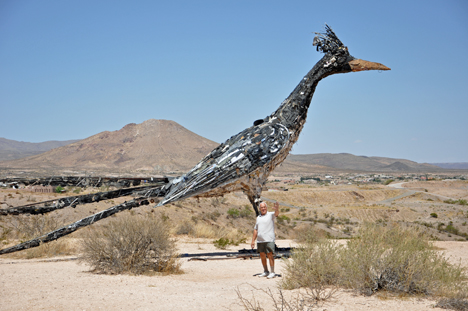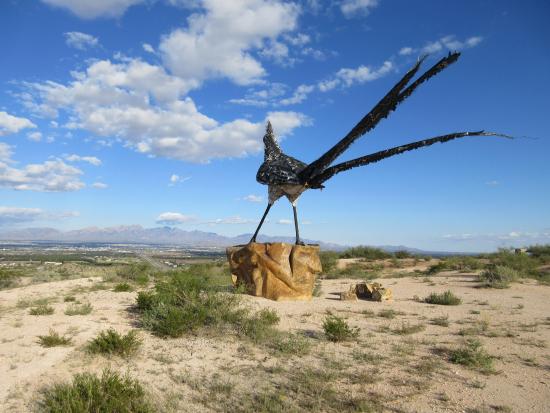
The Scrappy Sentinel of the Southwest: Unpacking the Enduring Allure of Las Cruces’ Big Bird
On the sun-baked plains of Southern New Mexico, where the Chihuahuan Desert stretches towards the distant Organ Mountains, an unlikely sentinel stands guard. Not a towering mesa or a historic mission, but a colossal roadrunner, fashioned from scrap metal, rebar, and the discarded detritus of human industry. This is the Las Cruces Big Bird, an iconic, whimsical, and deeply beloved roadside attraction that has transc transcended its humble origins to become a powerful symbol of local ingenuity, artistic spirit, and the enduring charm of the American Southwest.
Towering approximately 20 feet tall and stretching some 40 feet in length, this metallic marvel is a mosaic of rust-colored history. Its feathers are crafted from meticulously welded pieces of sheet metal, its legs from stout pipes, and its piercing eyes from polished hubcaps or other found objects that catch the desert light. Perched eternally in a dynamic pose, as if frozen mid-stride, it embodies the speed and tenacity of New Mexico’s state bird. For nearly three decades, it has greeted travelers along Interstate 10, just west of Las Cruces, offering a moment of unexpected joy, a compulsory photo opportunity, and a distinct sense of place.
The story of the Big Bird is inextricably linked to its creator, Olin C. Calk, a local welder and visionary whose artistic philosophy was rooted in resourcefulness and a deep appreciation for the beauty of salvaged materials. Calk, often described as an unassuming artisan with a penchant for turning industrial cast-offs into whimsical wonders, began constructing the colossal bird on his property in the early 1990s. He famously worked with whatever materials he could find, transforming scrap metal, rebar, pipes, and old farm equipment into his creations. This approach not only made his art accessible and sustainable but also imbued each piece with a unique narrative, a second life for objects once destined for the junkyard.

Calk’s motivation, by many accounts, was simple: to create something grand, something memorable, and something that reflected the spirit of his home. The roadrunner, a creature of tenacity and speed, perfectly suited to the arid landscape, was a natural choice. It is a bird that thrives in harsh conditions, much like the people of the desert, and its quirky, almost comical gait has endeared it to generations. Calk envisioned a monument that would celebrate this local icon, a landmark that would put a smile on people’s faces and signal to passersby that they were truly in New Mexico.
The construction of the Big Bird was not a quick endeavor. It was a labor of love, undertaken in stages, with the artist meticulously shaping and welding each component. Locals recall seeing the bird slowly take shape, growing piece by piece on Calk’s land, a testament to his dedication and skill. As it neared completion, its sheer scale and intricate detail began to draw attention, first from neighbors, then from curious drivers who would pull over to marvel at the emerging giant. The bird’s unpretentious charm and the visible effort behind its creation resonated deeply with the community.
Upon its completion around 1993-1994, the Big Bird quickly cemented its status as more than just a roadside curiosity. It became an unofficial welcoming committee, a beloved symbol of Las Cruces, and a point of pride for residents. Children growing up in the area learned to spot it from the car window, a familiar and comforting landmark on family trips. For tourists, it became an essential stop, a quirky antidote to the monotony of highway driving. The sight of people pulling off the interstate, cameras in hand, to pose with the metallic avian, became a common occurrence.
Beyond its physical grandeur and the immediate delight it evokes, the Las Cruces Big Bird carries a deeper symbolic weight. It is a powerful example of "outsider art" or "folk art," created not for the gallery space or critical acclaim, but for the sheer joy of creation and the public’s enjoyment. It speaks to the idea that art can be found in unexpected places, made from unconventional materials, and born from the hands of an everyday individual. Calk’s work democratized art, making it accessible to everyone, regardless of their background or artistic knowledge.
The Big Bird also serves as a testament to the power of human ingenuity and resourcefulness. In an era increasingly focused on mass production and disposability, Calk’s sculpture stands as a bold statement about recycling and giving new life to old materials. Each piece of scrap metal integrated into the bird’s form tells a silent story of its previous existence, contributing to the rich tapestry of the finished artwork. This "upcycling" message resonates strongly in a region that understands the value of making do with what you have.
Furthermore, the roadrunner has become an emblem of the unique character of the American Southwest. It’s a region known for its vast, open spaces, its rugged beauty, and its independent spirit. The Big Bird, standing alone yet commanding attention, mirrors this ethos. It is a landmark that doesn’t rely on flashy lights or commercial fanfare; its appeal lies in its authenticity, its handcrafted nature, and the genuine spirit of its creator. It’s a touchstone for a simpler, more imaginative time, a reminder that wonder can be found just off the beaten path.
Over the years, the Big Bird has remained largely untouched by the elements, a testament to Calk’s sturdy welding and choice of durable materials. Its surface has weathered, gaining a deeper, richer patina of rust that only enhances its character and blends it further into the desert landscape. It stands as a permanent fixture, an unwavering presence that has witnessed countless sunrises and sunsets, seasons of blooming desert flora, and generations of travelers passing by.
While Olin C. Calk himself passed away, his magnificent roadrunner continues to stand as his enduring legacy. It’s a piece of public art that has fostered a sense of community pride and identity, inspiring countless local anecdotes and becoming a quintessential part of the Las Cruces experience. It reminds us that sometimes, the most profound and beloved works of art are not found in museums, but in unexpected places, created by humble hands with boundless imagination and a desire to bring a little more beauty into the world.

In a world increasingly homogenized by global trends, the Las Cruces Big Bird remains a fiercely individual and uniquely regional icon. It is a powerful illustration of how one man’s vision, combined with resourcefulness and a love for his home, can create a lasting landmark that transcends time and continues to captivate the hearts and imaginations of all who encounter it. As the sun sets behind the Organ Mountains, casting long shadows across the desert, the metallic roadrunner continues its silent vigil, a scrappy, enduring sentinel of the Southwest, forever welcoming travelers to the vibrant heart of New Mexico.


